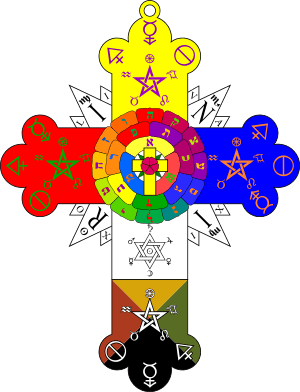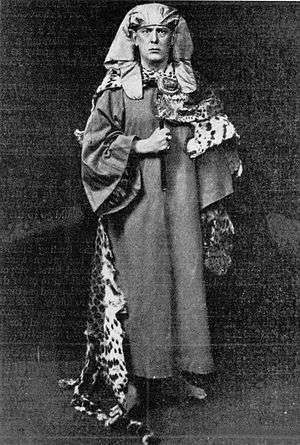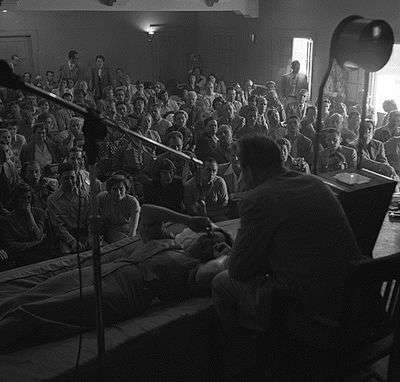Scientology and the occult


Scientology founder L. Ron Hubbard claimed to have had a near-death experience in 1938 that inspired him to write Excalibur, an unpublished manuscript based on the revelations from the experience. In 1945-46, Hubbard was briefly involved with Jack Parsons, an American Thelemite and member of the Agape Lodge of Aleister Crowley's magical order, Ordo Templi Orientis, in Pasadena, California.[1] In 1950, he published Dianetics: The Modern Science of Mental Health, and in 1953 he organized the Church of Scientology.
The occult (from the Latin word occultus "clandestine, hidden, secret") is "knowledge of the hidden".[2] In common English usage, occult refers to "knowledge of the paranormal".[3] It also describes a number of magical organizations or orders.
Hugh B. Urban, a scholar on religion who has written much about Scientology, writes that while some writers, such as Jon Atack, assert that Crowley’s ideas on magic are at the core of Scientology, others, including Roy Wallis and J. Gordon Melton, have dismissed the connection between occultism and the Church. He argues further that the occult elements are combined with concepts in Eastern religions, science fiction, pop psychology and Hubbard’s own thoughts, while confirming that there is one element that is related to the occult in the religion.[4]
Hubbard's early interest in the occult
Hubbard's eldest son, Ronald DeWolf, related a story that L. Ron Hubbard had "first discovered Magick" at the age of sixteen when he read Aliester Crowley's The Book of the Law. Author Jon Atack reports that Hubbard joined the Rosicrucian order Ancient and Mystical Order Rosae Crucis (AMORC) in 1940, completing the first two neophyte degrees. According to Atack, Hubbard's membership lapsed on July 5, 1940.[5][6]
Near-death experience and Excalibur
In April 1938, Hubbard reportedly had a bad reaction to a drug during a dental procedure. According to his account, this caused a near-death experience. Allegedly inspired by this experience, Hubbard composed a manuscript, which was never published, with working titles of "The One Command" or Excalibur.[7][8] The contents of Excalibur formed the basis for some of his later publications.[9]
Arthur J. Burks, who read the work in 1938, later recalled it discussed the "one command": to survive, a theme that Hubbard revisited in Dianetics: The Modern Science of Mental Health. Burks also recalled that the work discussed the psychology of a lynch mob.[10] Hubbard cited Excalibur as an early version of Dianetics: The Modern Science of Mental Health.[11]
Aleister Crowley's magical order

In August 1945 Hubbard moved into the Pasadena mansion of John "Jack" Whiteside Parsons, an avid occultist and Thelemite, follower of the English ceremonial magician Aleister Crowley and leader of a lodge of Crowley's magical order, Ordo Templi Orientis (OTO).[12][13] Parsons and Hubbard collaborated on the "Babalon Working", a sex magic ritual intended to summon an incarnation of Babalon, the supreme Thelemite Goddess.[14]
In 1969, The Sunday Times published an expose detailing Hubbard's experiences with Parsons and the OTO.[15]
Hubbard's experience with hypnosis
Hubbard was known to his associates in the late 1940s as a talented hypnotist.[16] During this period, he worked in Hollywood posing as a swami.[17] The Church says that Hubbard's experience with hypnosis led to his discovery of the principles of Dianetics as a technique for solving man's problems.[18]
Affirmations
The "Affirmations" is a document purportedly written by Hubbard in the late 1940s, a few years before he established Dianetics (1950) or Scientology (1952). The Affirmations appear to have been intended to be used as a form of self-hypnosis.
Many suggestions encourage Hubbard to believe in his own occult powers:
- "That I believe in my gods and spiritual things."
- "That my magical work is powerful and effective."
- "You are psychic."
Several suggestions reference a guardian spirit:
- "You can do automatic writing whenever you wish. You do not care what comes out on the paper when your Guardian dictates."[19]
- "Nothing can intervene between you and your Guardian. She cannot be displaced because she is too powerful. She does not control you. She advises you."
- "The most thrilling thing in your life is your love and consciousness of your Guardian."
- "You can talk with her and audibly hear her voice above all others."
Another suggestion involves numerology: "That the numbers 7, 25 and 16 are not unlucky or evil for me."
Scholars have noted that the Affirmations contain themes that reappeared later in Scientology.[14] One Affirmation foreshadows Hubbard's future interest in mental healing: "You understand all the workings of the minds of humans around you, for you are a doctor of minds, bodies and influences."[20] Lawrence Wright suggests "Hubbard is using techniques on himself that he would later develop into Dianetics." He draws parallels with the practice of "auditing" used in Dianetics and Scientology, noting that the Affimations and Dianetics both involve tackling difficult memories that hold back mental and spiritual progress.
The Affirmations became public knowledge in during the 1984 lawsuit against Hubbard's former archivist. In that settlement, Armstrong was required to return "all originals and copies of the documents commonly known as the 'Affirmations' written by L. Ron Hubbard". As religious studies scholar Hugh Urban comments, "here the church clearly indicates that the text was written by L. Ron Hubbard, and it seems difficult to understand why the church would file suit to retain ownership of the text were it not an authentic document."[14]
Dianetics

In a 1949 letter to Forrest Ackerman, Hubbard promises his upcoming work will give Ackerman the power to "rape women without their knowing it, communicate suicide messages to your enemies as they sleep, sell the Arroyo Seco Parkway to the mayor for cash, evolve the best way of protecting or destroying communism".[11] Hubbard admits he has "not decided whether to destroy the Catholic church or merely start a new one."[11]
In 1950, Hubbard published an article entitled "Dianetics: the Evolution of a Science" in the magazine Amazing Stories. In that article, Hubbard discusses the use of hypnosis, automatic writing, automatic speaking and clairvoyance.[21]
Philadelphia Doctorate Course
In December 1953, Hubbard recorded a series of audio lectures in which he connects Crowleyite magical rituals and the practice of Scientology.[22] Hubbard explains the use of Tarot,[23] and discusses "the magic cults" of the 8th-12th centuries. He recommends The Master Therion as "the only modern work that has anything to do with them". He describes the book's author, Aleister Crowley, as "my very good friend," though there is some question about his intent in this remark because Hubbard never met Crowley personally.[24] Hubbard also explains that Crowley "signs himself "The Beast"; "The Mark of the Beast, 666."" [25]
In The Book of the Law, Crowley wrote "The whole and sole object of all true magickal training is to become free from every kind of limitation." Hubbard repurposed this for his movement, lecturing that "Our whole activity tends to make an individual completely independent of any type of limitation.... Old Aleister Crowley had some interesting things to say about this. He wrote the Book of the Law."[25] Ronald DeWolf, Hubbard's eldest son, wrote that "In preparation for the next day's lecture, [Hubbard]'d pace the floor, exhilarated by this or that passage from Aleister Crowley's writings."[26]
"Original" OT8
Operating Thetan level VIII is highest level of auditing level in Scientology. It is known as "The Truth Revealed". It was initially released to select high-ranking public Scientologists in 1988.[27]
In OT VIII, dated 1980, Hubbard explains the document is intended for circulation only after his death. Its purpose is to explain the untold story of Hubbard's life's work.[28] Hubbard explains that the reader has "undoubtedly heard pieces of data over the years that hinted at the greater untold reality of my mission here on Earth" but "the story was never written, nor spoken... It is only now that I feel it safe to release the information".[29]
Hubbard mentions the Book of Revelation and its prophecy of a time when "an arch-enemy of Christ, referred to as the anti-Christ, will reign". According to Hubbard, the "anti-Christ represents the forces of Lucifer". Hubbard writes "My mission could be said to fulfill the Biblical promise represented by this brief anti-Christ period."[26]
In the document, Hubbard also teaches that "the historic Jesus was not nearly the sainted figure [he] has been made out to be. In addition to being a lover of young boys and men. he was given to uncontrollable bursts of temper and hatred".[30]
Authenticity
The document was posted to the Internet in 1995 as part of the Fishman papers. The Church of Scientology denies the document's authenticity, though notable defectors have described receiving the document as part of their training for the rank of OT8.
George White, a public scientologist who had received OT8 in the summer of 1988, asserts the document is authentic.[27][31] Frank Oliver, a former operative with Scientology's Office of Special Affairs, reports having discovered the document in the church's archives.[27] Jesse Prince, former second-in-command of Scientology's Religious Technology Center, reports that OTVIII was revised after early participants were "horribly upset" by the content.[27][32]
Ronald DeWolf statements
|
Day 1 and Day 2 | |
|
| |
|
| |
|
|
Lafayette Ronald Hubbard, Jr., Hubbard's eldest son, had been an active participant in the early days of Scientology. In 1959, he left Scientology and later took the name Ronald DeWolf.
In the mid-1980s, DeWolf gave a series of sworn statements and interviews detailing his father's history. DeWolf explained his father had been "deeply involved in the occult and black-magic." According to DeWolf, Aleister Crowley's death in 1947 was a pivotal event that led Hubbard to "take over the mantle of the Beast". DeWolf claimed that "Black magic is the inner core of Scientology", arguing that "my father did not worship Satan. He thought he was Satan."[33]
In 2014, Jamie DeWolf (Ronald's grandson) announced the discovery of Ronald DeWolf's unpublished memoir which had been written in 1981. That work discusses the Hubbards' history of occult practices.[34]
Notes
- 1 2 Urban, Hugh B. "The Occult Roots of Scientology?: L. Ron Hubbard, Aleister Crowley, and the Origins of a Controversial New Religion". JSTOR 10.1525/nr.2012.15.3.91.
- ↑ Crabb, G. (1927). English synonyms explained, in alphabetical order, copious illustrations and examples drawn from the best writers. New York: Thomas Y. Crowell Co.
- ↑ Underhill, E. (1911). Mysticism, Meridian, New York.
- ↑ Urban, Hugh B. (2012). "The Occult Roots of Scientology? L. Ron Hubbard, Aleister Crowley, and the Origins of a Controversial New Religion". The Journal of Alternative and Emergent Religions. 15 (3): 91–116. doi:10.1525/nr.2012.15.3.91.
- ↑ http://www.spaink.net/cos/essays/atack_occult.html
- ↑ http://www.american-buddha.com/cult.pieceofbluesky.2.3.htm
- ↑ http://www.npr.org/2013/01/24/170010096/going-clear-a-new-book-delves-into-scientology
- ↑ http://www.lermanet.com/excalibur/
- ↑ Hubbard, "The Anatomy Of Thought". Hubbard Communication Office Policy Letter 26 April 1970R, revised 15 March 1975.
- ↑ http://www.american-buddha.com/cult.yesbookcalledexcalibur.htm
- 1 2 3 http://tonyortega.org/2014/10/23/l-ron-hubbard-explains-to-a-friend-the-real-reason-he-wrote-dianetics/
- ↑ https://books.google.com/books/about/Going_Clear.html
- ↑ Miller, p. 113
- 1 2 3 Urban, Hugh B. Magia sexualis: sex, magic, and liberation in modern Western esotericism, p. 137. Berkeley, CA: University of California Press, 2006. ISBN 978-0-520-24776-5
- ↑ http://tonyortega.org/2013/09/28/10468/ http://www.lermanet.com/scientologynews/crowley-hubbard-666.htm
- ↑ Robinson, Jill (1997-11-11). "L. Ron Hubbard". Secret Lives. A&E.
- ↑ Hubbard, L. Ron (October 1958). The Story of Dianetics and Scientology, Lecture 18 (Speech).
- ↑ Hubbard, What is Scientology?, 1998 softcover edition, pg. 529.
- ↑ Wright, p. 53-4
- ↑ https://books.google.com/books?id=liDmBgAAQBAJ&pg=PT33
- ↑ http://www.matrixfiles.com/Scientology%20Materials/Books/EOS.PDF
- ↑ Urban, 2012
- ↑ http://tonyortega.org/2013/09/28/10468/
- ↑ Melton, J. Gordon (2000). Studies in Contemporary Religion: The Church of Scientology (1 ed.). United States: Signature Books. p. 67. ISBN 978-1-56085-139-4. Retrieved 15 May 2015.
In an off-the-cuff remark during the Philadelphia Lectures in 1952 (PDC Lecture 18), Hubbard referred to “my friend Aleister Crowley.” This reference would have to be one of literary allusion, as Crowley and Hubbard never met. He obviously had read some of Crowley’s writings and makes reference to one of the more famous passages in Crowley’s vast writings and his idea that the essence of the magical act was the intention with which it was accomplished. Crowley went on to illustrate magic with a mundane example, an author’s intention in writing a book.
- 1 2 http://www.xenu.net/archive/books/mom/Messiah_or_Madman.txt
- 1 2 http://www.cs.cmu.edu/~dst/Library/Shelf/wakefield/christians.html
- 1 2 3 4 http://tonyortega.org/2014/06/24/up-the-bridge-we-finally-reach-ot-8-but-was-its-first-version-really-a-hoax/
- ↑ "By the time you read this I will no longer be occupying the body and identity that you have known as Ron."
- ↑ http://www.cs.cmu.edu/~dst/Fishman/Declaration/ot8b.html
- ↑ http://tonyortega.org/2014/06/24/up-the-bridge-we-finally-reach-ot-8-but-was-its-first-version-really-a-hoax
- ↑ http://tonyortega.org/2015/02/06/scientology-vs-the-mayor-the-full-gabe-cazares-interview-from-1997s-secret-lives/
- ↑ http://www.xenu-directory.net/news/images/1998-interviews-prince.pdf
- ↑ http://www.lermanet.com/scientologynews/penthouse-LRonHubbardJr-interview-1983.htm
- ↑ http://tonyortega.org/2014/05/10/jamie-dewolf-ive-found-the-last-memoir-of-the-son-of-scientologys-founder/
See also
References
- Hugh Urban - The Occult Roots of Scientology?: L. Ron Hubbard, Aleister Crowley, and the Origins of a Controversial New Religion
- Hugh Urban - The Church of Scientology: A History of a New Religion